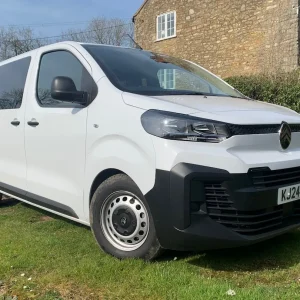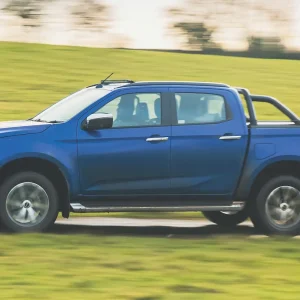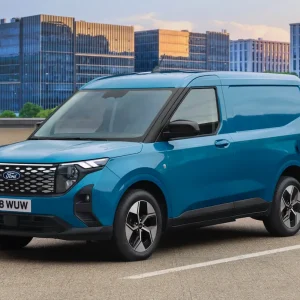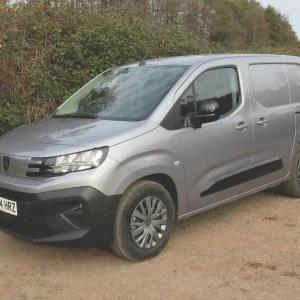All the brouhaha surrounding last year’s launch of Renault’s new Trafic somewhat eclipsed the arrival of a revised version of the Master, its bigger brother. Admittedly, the changes are far less drastic than those made to the Trafic, which was completely renewed, but they are still significant. The big change is the introduction of a new and more powerful 2.3-litre dCi diesel with outputs running from 110hp to 165hp compared with the 100hp to 150hp of the previous model.
The 135hp and 165hp versions of the latest offering are fashionably fitted with twin turbochargers. Their 110hp and 125hp stablemates come with just the one, and it is worth noting that they are not quite as fuel-efficient as the dual-turbo lumps according to official figures despite their lower power output.
A six-speed manual gearbox is fitted as standard whichever variant you pick, with an automated Quickshift6 ’box marketed as an option on the 125hp diesel.
A 150hp engine is also on offer, but only with Quickshift6. Both the 135hp and 165hp diesels are sold solely as energy engines with the 110hp unit marketed in either standard or energy guise. The energy designation means they are fitted with stop/start and energy Smart Management, a regenerative braking system that captures energy that would otherwise be lost during deceleration and uses it to help recharge the battery.
The two most powerful of the trio are additionally equipped with an eco button. Hit that and engine torque and the heater/aircon settings are altered to deliver a fuel economy improvement of up to 10%, says Renault.
Like Ford’s Transit, the Master can be ordered with either front- or rear-wheel-drive. With three lengths and three roof heights, load cubes range from 8.0m3 to 17m3 – an L4 single rear wheel rear-wheel drive model has been added to the latest line-up – and there is a choice of four gross weights: 2800kg, 3300kg, 3500kg or 4500kg. Van gross payloads run from 1000kg to 2254kg.
Bear in mind that the Master can be ordered as a van, a crew van, a chassis cab, a chassis double-cab, a platform cab, a six- or nine-seater Combi, as a 17-seater minibus and with a variety of special conversions. Dropsides, box vans, tippers and Lutons are all also offered.
A key rival in the UK market is Ford’s Transit, but buyers interested in a Master are in our view also likely to place Citroen’s Relay, Peugeot’s Boxer and Fiat’s Ducato towards the top of their shopping list. These three share the same basic design, but the Ducato employs different engines.
Mention should also be made of Vauxhall’s Movano and Nissan’s NV400. They are both based on the Master’s shared underpinnings, but with styling and specification differences.
We took to the highways in a front-wheel drive, medium wheelbase, medium height roof, 3.5-tonne Master energy van with the 110hp engine.
Load area
Rearentrytothe10.8m cargo bay is by means of twin full-height doors that can be swung through 90°, or 180 degrees if you release the stays. Alternatively, you can use the sliding nearside door. But whichever entry point you choose, you will appreciate one of the big advantages front-wheel drive has over rear-wheel drive: a lower loading height.
A dozen load tie-down points were provided in our test van to secure wayward cargo. A shelf above the cab that is accessible solely from the cargo area can be used to stow restraint straps. If anything does break loose then a full-height steel bulkhead should stop it from ending up in the front.
The nearest equivalent to our test van in the Transit line-up is the front-wheel drive L2 H3 medium-wheelbase high-roof 3.5-tonner with a 11.2m3 load bay. At 3044mm it gives you slightly less load length than our Master (the Renault’s key dimensions are overleaf) but more load height with 2125mm. At 1784mm and 1392mm respectively, maximum load width and clearance between the wheel boxes are a tad more generous. At 1488kg, and assuming you specify the 2.2-litre TDCi diesel at 100hp with stop- start, the Transit’s gross payload is 132kg lower, so the Master will haul over five standard bags of gravel more than the Ford. At 2000kg, the Transit’s permitted trailer towing weight is lower too.
Looking at Peugeot’s recently revised Boxer (which is sold solely with front-wheel drive) in
a medium wheelbase, medium roof configuration that provides 11.5m3, its load length is 3120mm with a notably generous load width of 1870mm, which narrows to a still healthy 1422mm between the wheel boxes. Load height is 1932mm. At 1575kg when powered by the 130hp 2.2 HDi diesel – the 110hp version is not available in the 3.5-tonner – the Boxer’s gross payload is significantly higher than the Transit’s but lower than the Master’s, with a maximum towing capacity of 2500kg.
Cab and equipment
The Master is marketed with two levels of specification: Business and Business+. The former gets you a driver’s airbag, DAB radio – new for the mildly restyled Master – and CD player with a USB socket, Bluetooth compatibility and a 12V power point, plus electric windows and heated and electrically adjustable exterior mirrors. The steering wheel is height-adjustable as is the driver’s seat, which also features lumbar adjustment and an armrest.
The aforementioned steel bulkhead comes as standard as does the usual alphabet soup of electronic safety systems.
Worth noting in particular is Renault’s decision to make Trailer Swing Assist standard
on the latest model. Part of the electronic stability control system, it helps to bring a trailer back under control if it develops a life of its own.
Also worthy of note, and a new standard feature, is Grip Xtend – an added-traction device designed to help you retain some purchase on loose surfaces. Hill Start Assist now forms part of the basic specification too.
Business+ adds manual aircon, rear parking sensors – they should really be standard on all vans of this size – and a 12V power point in the cargo area. Both Business and Business+ come with plenty of storage space in the three-seater cab, including big bins in each of the doors.
Flip down the back of the middle seat in a Business+ model and it turns into a desk. Pull up the passenger seat’s cushions and you will find a big storage compartment that is ideal for concealing anything bulky and valuable.
Our demonstrator came in Business trim but with a few extras. They included manual aircon, ply lining for the load area complete with a resin-coated ply floor, rear parking sensors and one-touch descent for the electric window on the driver’s side.
So far as the Transit is concerned you will pay more for aircon no matter whether you pick Base or Trend, Ford’s equivalents to Business and Business+, and you have to upgrade to Trend
if you want lumbar adjustment for the driver’s seat and electric mirrors, unless you want to buy them separately. What Trend does give you – along with metallic paint – is Ford Sync, which helps summon the emergency services if you are in a serious smash. Trend also delivers cruise control with an adjustable speed-limiter. Remember that the Transit can be ordered with econetic technology, which includes Smart Regenerative Charging as well as stop-start. On the options list are safety systems such as Lane Keeping Alert (Peugeot has a similar system as an option) and Adaptive Cruise Control.
The Boxer can be ordered in either Standard or Professional trim. Go for the latter and you get manual aircon, cruise control, rear parking sensors and a touch- screen with integrated navigation. Professional is not, however, available on the biggest models in the Boxer line-up.
As indicated earlier, the Master is marketed with a variety of options – the list includes a reversing camera, alloy wheels and satnav – and option packs as well as off-the-shelf van load area storage systems under the Ready4Work banner.
Powertrain
There is a strong argument that the amount of torque delivered by a van engine matters more than the headline power figure. At 110hp, the Master’s 2.3-litre diesel pumps out 285Nm at 1500rpm. The Boxer’s 130hp 2.2-litre delivers 35Nm more torque than the Renault lump but delivers it significantly higher up the rev band, at 2000rpm. At 100hp the Transit offers 310Nm across a 1300rpm to 2100rpm plateau. All three vans come with a standard six-speed manual gearbox, with the Master the only one marketed with an optional automated box.
Chassis and steering
All Master vans sit on 16-inch wheels. MacPherson struts helped support our van’s front end, with single-leaf springs installed at the back. The Transit and Boxer follow much the same approach. Our Master boasted a 14.1m turning circle between walls shrinking to 13.6m between kerbs. With our comparison Transit there’s a far tighter turnaround – 12.6m and 11.9m – while Boxer circles are 12.8m and 12.6m respectively.
Performance
Maybe it was because it had a mere 454 miles on the clock and a tight engine as a consequence, but our demonstrator took a while to get into its stride. Departure from rest was stately rather than rocket- like, and acceleration through the gears was never exactly brisk.
The ride proved compliant, but handling through bends is nowhere near as sharp as Transit’s, and the Renault will break away more quickly than the Ford if you push it hard. All Transits are fitted with Curve Control, which helps ensure you stay on the road if you take a bend too quickly.
Nor are noise levels as well- suppressed. Subjectively, we experienced a lot more in-cab racket than we did with the Transit, with wind, engine and road noise all making their presence felt.
All vans of Master’s size suffer from a nearside blind spot. Renault has cleverly decided to cover it by mounting a wide-angle mirror on the inside surface of the passenger- side sun visor. Standard with Business+, but a cost option otherwise, it is an arrangement that works reasonably well, albeit at the risk of making any passengers – who will be staring straight at it for mile after mile – feel distinctly queasy.
Buying and running
Our test van’s official combined fuel economy figure is 37.2mpg, and with a tight engine and a heavy right foot the writer was still averaging 33mpg to 34mpg. That was with the benefit of the stop-start system, which cut in and out smoothly.
The equivalent Transit with stop-start will give you 38.7mpg, again according to official statistics, while the closest Peugeot model to our Master comes in at 38.2mpg. CO2 emissions are 194g/km (Transit) 195g/km (Boxer) and 201g/km (Master).
The Master service intervals are set at two years/25,000 miles while both Transit and Boxer are ahead of the game at two years/30,000 miles.
The Master scores strongly on warranty cover, with a four- year/100,000-mile deal, with no mileage limit in the first two years and including roadside rescue for the duration. Both the Boxer and Transit are covered by three- year/100,000-mile packages with roadside rescue for the first year.
Finally, as for the front-end basic price, it’s £24,355 for the Boxer, £24,870 for the Master and £25,395 for the Transit, plus £200 for stop-start.
Verdict
Renault’s package of sensible, well thought-out changes plus a decent payload capacity has made Master even more of a useful workhorse.
History
The Master can trace its roots back 35 yearstothelaunchoftheoriginal –and somehow very French-looking – model back in 1980.
One of its big advantages was its ability to shift weight, with one version having the capacity to cart around roughly 1.8 tonnes of cargo; way more than a modern 3.5-tonner can manage. However, Masters of that vintage did not boast the level of kit their modern counterparts enjoy.
Debuting in 1997, the second- generation van was a lot more conventionalinappearance. Ajoint- venture agreement between Renault and Vauxhall’s parent firm General Motors meant it was also marketed as the Vauxhall Movano, with Renault’s stablemate Nissan eventually selling it as the Interstar.
A facelift followed in 2003, with an all-new model debuting in 2010. It, too, was sold by Vauxhall and Nissan, with the latter promoting it as the NV400.
Renault’s package of sensible, well-thought-out changes plus a decent payload capability has made Master even more of a useful workhorse.
Renault’s package of sensible, well-thought-out changes plus a decent payload capability has made Master even more of a useful workhorse.
Renault’s package of sensible, well-thought-out changes plus a decent payload capability has made Master even more of a useful workhorse.





